As 3D printing technology progresses, we are seeing all sorts of new materials hit the market. Composite polymers, new proprietary resin formulations, and entirely new material types altogether, have been streaming into  the 3D printing space. With that said, there are also companies like Structur3D who have looked in the opposite direction for 3D printing material ideas. Instead of researching and creating new foreign materials, they have took a much simpler approach in creating an extruder, the ‘Disco3ry extruder‘, which allows a 3D printer to extrude some of the most fundamental materials we all have lying around our homes and offices. Both approaches have led to an increase in applicable uses of 3D printers, and certainly is helping move the market froward.
the 3D printing space. With that said, there are also companies like Structur3D who have looked in the opposite direction for 3D printing material ideas. Instead of researching and creating new foreign materials, they have took a much simpler approach in creating an extruder, the ‘Disco3ry extruder‘, which allows a 3D printer to extrude some of the most fundamental materials we all have lying around our homes and offices. Both approaches have led to an increase in applicable uses of 3D printers, and certainly is helping move the market froward.
A Polish company named Tytan 3D has taken the latter approach, similar to that of Structur3D. Instead of creating just an extruder, they have created an entirely new 3D printer. Unlike the typical delta 3D printers on the market today, which rely on fused deposition modeling to melt plastic polymers as they are extruded from a print head, Tytan 3D’s printer works in an entirely different way. There are no hardened plastic polymers involved here, and there is no heat required for printing. Instead the Tytan 3D Delta printer extrudes self-hardening materials, which when they dry, create structurally sound objects.
The company, run by Janusz Wojcik and Pawel Rokita — two of the most recognizable names withing the Polish 3D printing scene, certainly is thinking outside the box. The new delta printer, once launched, will have the capabilities of printing in a variety of materials, including the following:
- Flour and salt mixture (when dried, gets extremely hard and is easy to paint)
- Paper pulp (mixture of ground paper, flour and glue)
- Food (preferably foods which can be extruded as a liquid and harden when dried, like chocolate)
- Adhesives (like caulk)
- Many other self hardening materials
The Tytan 3D delta printer will have a large build envelope, with a print diameter of 20 cm, and a print height of 35 cm. We are told that the printer is very sturdy, with aluminum poles attached to an artificial stone based. It also uses a simple cartridge system, which allows for the easy removal and installation of the material filled cartridges. When they become empty during a print, the printer stops and allows for the installation of another full cartridge, prior to restarting where it left off. Because of its ease to use, Wójcik told 3Dprint.com that the machine will be targeted towards almost everyone, including professionals, amateurs, students, children and adults.
The Tytan 3D printer is still in production, with a working prototype unveiled at a fair in Kielce, Poland recently. The company expects a finished version to go on display at an upcoming event in Warsaw, Poland in a couple of weeks. No price point has been set for the device yet, however, one should be forthcoming shortly.
Let us know what you think about this new multi-material 3D printer in the Tytan 3D Delta Printer forum thread on 3DPB.com.
Subscribe to Our Email Newsletter
Stay up-to-date on all the latest news from the 3D printing industry and receive information and offers from third party vendors.
You May Also Like
Precision at the Microscale: UK Researchers Advance Medical Devices with BMF’s 3D Printing Tech
University of Nottingham researchers are using Boston Micro Fabrication‘s (BMF) 3D printing technology to develop medical devices that improve compatibility with human tissue. Funded by a UK grant, this project...
3D Printing Webinar and Event Roundup: April 21, 2024
It’s another busy week of webinars and events, starting with Hannover Messe in Germany and continuing with Metalcasting Congress, Chinaplas, TechBlick’s Innovation Festival, and more. Stratasys continues its advanced training...
3D Printing Webinar and Event Roundup: March 17, 2024
It’s another busy week of webinars and events, including SALMED 2024 and AM Forum in Berlin. Stratasys continues its in-person training and is offering two webinars, ASTM is holding a...
3D Printed Micro Antenna is 15% Smaller and 6X Lighter
Horizon Microtechnologies has achieved success in creating a high-frequency D-Band horn antenna through micro 3D printing. However, this achievement did not rely solely on 3D printing; it involved a combination...






























